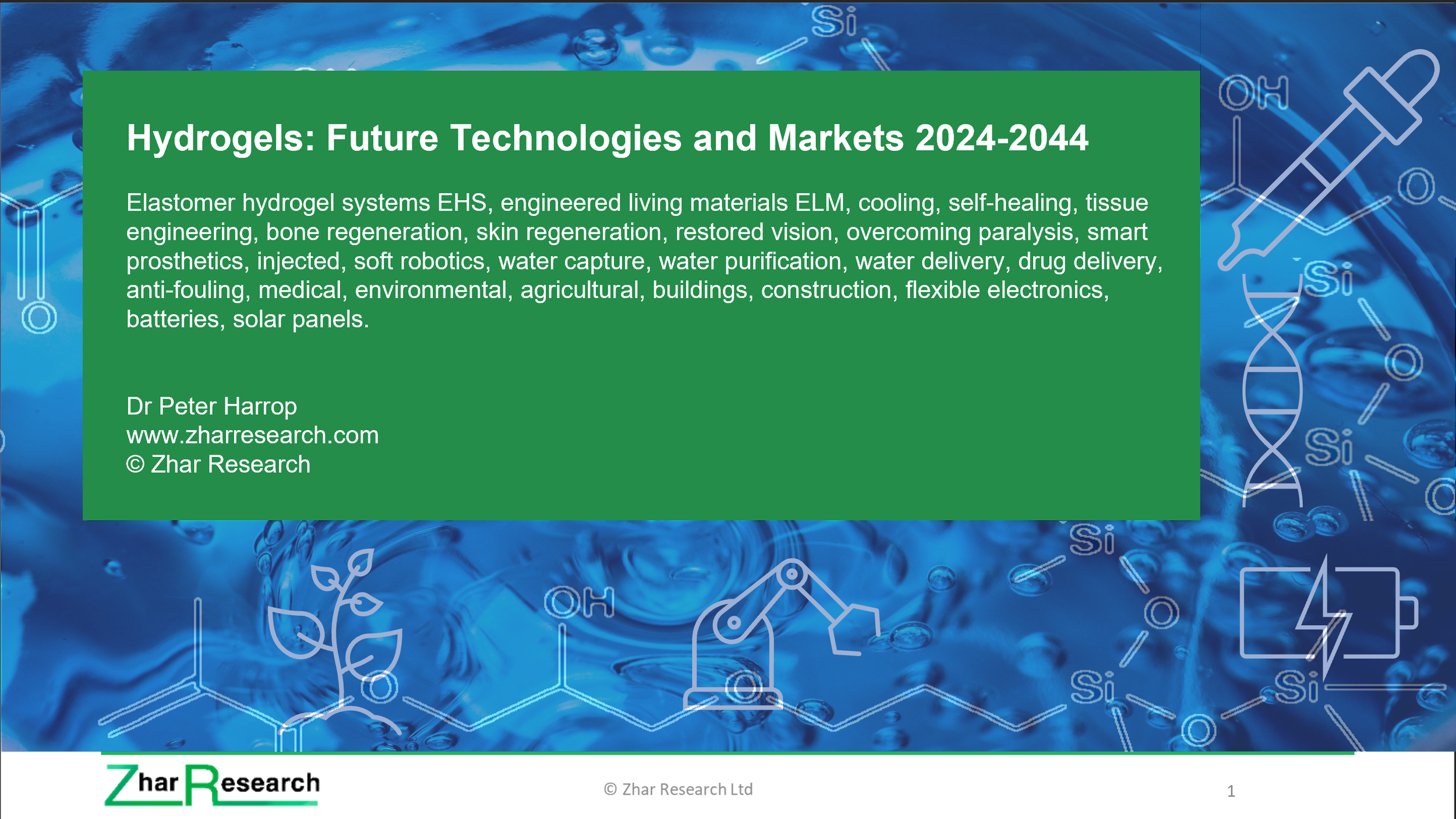Hydrogel Business Opportunities 2024-2044
Infogram of hydrogel market expansion 2024-2044. Source Zhar Research report, ““Hydrogels: Future Technologies and Markets 2024-2044”.
The new Zhar Research 300-page report, “Hydrogels: Future Technologies and Markets 2024-2044” uniquely focuses on new technologies and applications that will add to the market, so it powers to over $75 billion predicted in 2044 with 5.1% CAGR.
The 28-page Executive Summary and Conclusions is the quick read. Grasp definitions, needs, graphics and data revealing the global market 2024-2044 by value, region, technology. See a hydrogel SWOT appraisal and roadmap 2024-2044 by industry sector and 26 background forecasts for equipment that will incorporate hydrogels.
Chapter 2 (13 pages) Introduction explains history, benefits, market drivers. View formulations, limitations, choice of natural vs synthetic and how, so far, most of the commercial success and research is in healthcare. 23 examples of medical hydrogel applications are tabulated against 19 others. What hydrogel toxigens are an issue? See types of main concern and their effects. The research pipeline is illustrated with 20 examples of hydrogel research and 42 companies commercialising hydrogels.
Medical applications of hydrogels dominate the market today and have the most ambitious objectives and funding so Chapter 3 (26 pages) concerns, “How hydrogels will be improved for medical and other purposes 2024-2044” and other chapters include medical aspects. Here are the molecular toolkit and trends, six families of emerging hydrogel chemistry and functionality and future hydrogel enabling technology by six other categories covered deeply in later chapters. How will silicones and polyurethanes both compete with and combine with hydrogels? With new appraisals, comments and predictions, here are the most promising routes to improvement 2024-2044, including new biomimetics, composites and chemistry, appraisal of a flood of important new research in 2023. Understand Elastomer Hydrogel Systems EHS and evolving production technologies for hydrogels including 3D and 4D printing.
Chapter 4. “Future hydrogels that cool buildings, solar panels, people, food, other” (45 pages) interprets these needs and possible solutions. New infogram: Major new cooling and thermal management needs arrive 2024-2044 leads five new infograms on the cooling toolkit and the hydrogel opportunity. Zhar Research explains hydrogel evaporative cooling in general, future hydrogel technologies for cooling of 6G microelectronics and solar panels, hydrogel-silica aerogel, even thermogalvanic hydrogel for synchronous evaporative cooling. Discover possible hydrogel cooling of solar panels including gathering useful water, hydro-ceramic hydrogel cooling of architecture, hydrogel windows to block and store heat. Learn how aerogel and hydrogel working together may cool pharmaceuticals and food. Assess a self-cooling smart actuator for soft robotics. Examine emerging cooling hydrogels for food, apparel, next microchips, power electronics, data centers, large batteries, cell towers and buildings.
Hydrogels are the leading option for future self-healing so Chapter 5. “Future self-healing hydrogels” has 58 pages, despite many new infograms. See definitions, focus, basics and drivers. Here are intrinsic or extrinsic self-healing hydrogel, the value chain, types of damage to people and things addressed, metrics, SWOT appraisal, technology options for self-healing hydrogels. Then comes a deep dive into physical and chemical hydrogel self-healing, competing formulations, important examples in the research pipeline. Learn self-healing hydrogels planned for anti-fouling, water-oil separation, liquid transportation, bone regeneration, drug-delivery and as cancer therapy injectables. Add their emerging use as electrical conductors for electronics and medical purposes, remote near-infrared-responsive controls, self-lubricating water-based polymeric systems, sensing, solid state electrolytes, spinal cord implants for treating paralysis, soft robotics, smart prosthetics, bioelectronics, cartilage, stretchable hydrogels for protein delivery, tissue engineering and triboelectric nanogenerators.
Chapter 6 takes 18 pages to cover, “Future hydrogel membranes and film: ion-exchange, gas separation, other”. Zhar Research finds that hydrogels have a future here but not a leading position. Some of the aspects covered are membrane difficulty levels, needs for self-healing and membrane chemistry in recent studies. Then come proposed hydrogel membranes - architectural, acoustic, battery, supercapacitor, fuel cell, electrolyte and sensorised e-skin for humans and robots. Hydrogels as gas separation, ionic conductors and ultrafiltration are also covered.
The 21 pages of Chapter 7 cover future hydrogel flexible electronics, sensors and solid-state energy storage. See chosen chemical routes: carbon, polymer, biopolymer, biomass then biopolymer hydrogel routes in more detail followed by flexible and solid-state energy storage examples including zinc-air battery electrolyte, biopolymer-based hydrogel electrolytes, supercapacitor, fuel cell, electrolyser and magneto-responsive hydrogels for biotechnological and environmental applications. Excitation-responsive, sensors, transistors, thermal hydrogels for electronics are appraised from research with Zhar Research predicting hydrogel contribution not dominance.
Chapter 8 covers “Future hydrogel Engineered Living Materials ELM” that some observers trumpet as “the next big thing” but Zhar Research advises caution, forecasting significant commercial impact but over a decade from now. See an overview, hype curve, infogram, SWOT appraisal, competition for ELM, Engineered Living Hydrogels ELH and their competition, taxonomy and obstacles with a recommended way forward for both bio-ELM and hybrid ELM where hydrogels are central. Finally, mycelial and bacterial forms are examined in more detail.
Chapter 9 at 22 pages explains future hydrogel water management: agriculture; waterproofing, anti-fouling, bio-separation. See sections on removing contaminants, bio-separation of proteins and extracting useful water from the air.
Zhar Research reveals research showing metal oxide frameworks competing with hydrogels, water harvesting even while warming and precious metal recovery with reusable hydrogel. Marine recovery of coral reefs and measuring and controlling agricultural runoff pollution currently damaging coral reefs both call for hydrogels as do marine anti-fouling film and paint, all covered here. Understand agricultural soil conditioning and irrigation and some companies and research projects involved.
Chapter 10. “Future hydrogel materials in building and construction” ends the report with 14 pages on inducing hydrogel in concrete and coating concrete with it. See some company advances, polyacrylic hydrogel in cement composites, hydrogels containing nano-silica enhancing cement pastes, improved concrete with hydrogel-based internal curing agents and other options.
Zhar Research report, “Hydrogels: Future Technologies and Markets 2024-2044” is essential reading for everyone wishing to research, fund, regulate, supply or use hydrogel materials and structures. Billion-dollar new businesses await.


